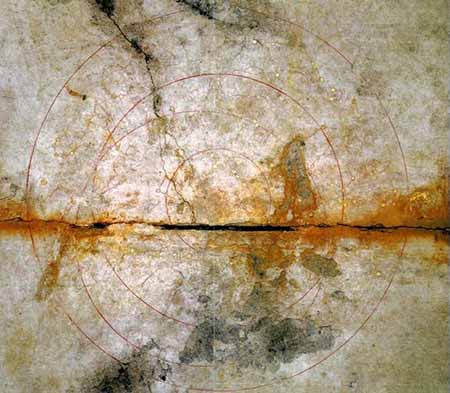
Stars that played a significant role in the lives of common citizens in Japan were often given the distinction of being called Yowatashi Boshi or passing the night stars. This phrase was applied to prominent star groups which would appear in the East at sunset and set with the dawning sun. Orion is certainly one of the most noticeable Yowatashi Boshi in the sky.
In most every culture, it is easily recognized and continues to grab the attention of children and adults throughout the long winter nights. The grouping of stars that form the constellation, most especially the three belt stars or Mitsu Boshi have played a major role in Japan's cultural heritage with the sky.
As one of many groups of stars with which Japanese formed associations, Orion is a particularly rich "case study" in the ways in which Japanese historically made the sky a part of their lives. In the case of Orion, Japanese have seen few if any individual gods or heroes or even mythological creatures within the constellation as a whole but rather icons of common knowledge or use and symbols of specific cultural values and attributes.
While some star lore reflects a kind of national "consciousness", there is no singular Japanese interpretation of the star patterns but rather a variety of objects, memorialized events, seasonal markers, symbols of religious value, and legends based on particular geographical regions and functional needs of ordinary citizens.
Mysterious ancient star chart shows foreign skies Live Science - July 20, 2015

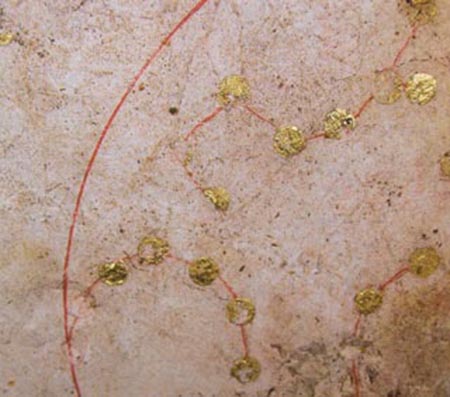
The astronomical chart on the ceiling of the Kitora Tomb. Agency for Cultural Affairs The Kitora Tomb, located near the village of Asuka in Japan's Nara Prefecture, is known for gorgeous, colorful paintings at the four cardinal points of the compass. A black tortoise guards the north of the ancient tumulus, which has been standing since the seventh or eighth century. A red phoenix stands at the south, a white tiger at the west and a blue dragon at the east. The ceiling of the tomb is decorated differently, with a map of the night sky, charting 68 constellations, with the stars picked out in gold leaf. Three concentric circles are drawn with vermilion, showing the movement of celestial objects, one of which is the sun.
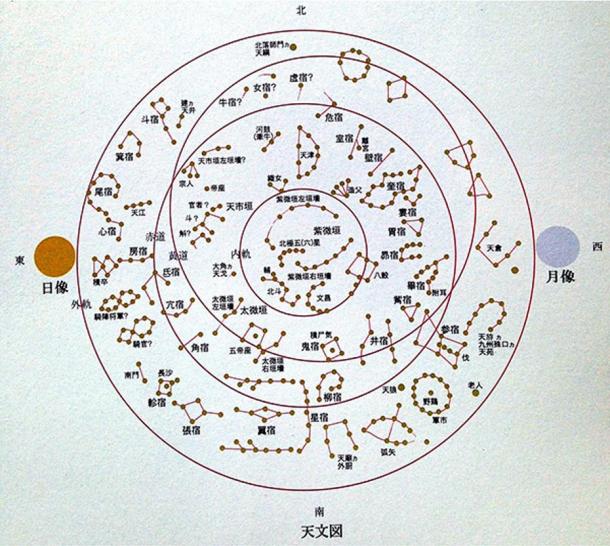
The Japanese Agency for Cultural Affairs have announced that a star chart discovered in ancient Asuka in the country’s Nara Prefecture, is based on much older celestial observations made in China, The Asah Shimbun has reported. The star chart was discovered in the Kitora Tomb in Asuka village in 1998, a site dated from the late 7th century to early 8th century, making it the oldest existing star map of its kind in the world. It features 68 constellations in which the stars are depicted using gold discs. The movement of celestial objects is also represented in the form of three concentric circles with another circle depicting the movement of the sun. The Polar Star is depicted at the center.
Analysis of digital images showed that the most likely observation sites were those located on the 34th parallel north, including the ancient cites of Chang’an (modern Xi’an) and Luoyang, both of which were capitals of Chinese dynasties governing the middle reaches of the Yellow River.
Mirrors of Orion: Star Knowledge of the Ancient World
The mysterious monoliths of Asuka Nara and the Rock Ship of Masuda
Soma and Nakamura believe the observations were made several hundred years before the Kitora Tomb was constructed. Soma thinks it may have been between 240 and 520 AD, while Nakamura prefers a time period of 120 to 40 BC. Using this as a basis, Kazuhiko Miyajima, a former professor of East Asia astronomy history at Doshisha University, has suggested that the star chart depicts the sky in 65 BC, in either Pyongyang, the capital of North Korea, or Seoul, the capital of South Korea.
The Kitora Tomb is located in an ancient tumulus near the village of Asuka and was first discovered in 1983. Experts believe it dates to some point between 7th and early 8th Centuries AD. The tomb consists of a small stone chamber just over 1 meter (3.3 feet) high, 1 meter (3.3 feet) wide and around 2.4 meters (7.9 feet) long.
The walls are orientated to the four cardinal points of the compass and images on them depict the Black Tortoise of the North, the Azure Dragon of the East, the Red Bird of the South and the White Tiger of the West. These representations are accompanied by additional zodiacal images consisting of human figures with animal heads. The murals were discovered when probes were inserted into the tomb in 1983. A second probe inserted in 1998 found more images and the star chart painted on to the ceiling.
Many of the murals were removed 2004 and 2008 to protect them from deterioration. Some of them are being restored in a special facility in the village. The chamber would only have been large enough to bury one person. This individual was laid to rest in a lacquered coffin which was broken during a tomb robbery and the fragments were scattered on the floor. The chamber also contains grave goods and shards of human bone. Artifacts discovered at the site include a gold fitting and pieces of a decorated sword. The evidence suggests an adult male of mid to late age, probably of an aristocratic background.
The discovery of the star chart is now the subject of much debate, prompting further discussion about the history of astronomical technology in Japan. A number of scientific papers have been published on the topic, including by Professor Miyajima who argues that such charts were often used for ritual and divination.
Over the centuries, a number of objects which represent aspects of Japanese culture have been seen in the stars of Orion. Origins of the objects themselves as well as how they came to be represented in the sky are unclear, but each has characteristics that make it unique as a celestial Japanese cultural icon. Following accepted IAU areas and nomenclature, Modern Star Atlases published in Japan use the Katakana form of "Orion"; however, most children learn the term tsuzumi boshi to visualize the constellation.
As a standard instrument of both Nou and Kabuki drama, tsuzumi is a Japanese drum. It has heads on both ends and is beaten with the fingertips. Many drums of this type are thought to have been introduced into Japan prior to the Nara period (710-794). Especially as they are used in court music, tsuzumi still retain much of their original form. Strings are used to tie the heads from end to end, and the pattern gives the drum a somewhat hourglass appearance.
The stars Betelgeuse and Gamma Ori form one end of the drum while the stars Rigel and Kappa Ori form the other. The three belt stars represent the cord that is used to tie the strings snugly in the middle.
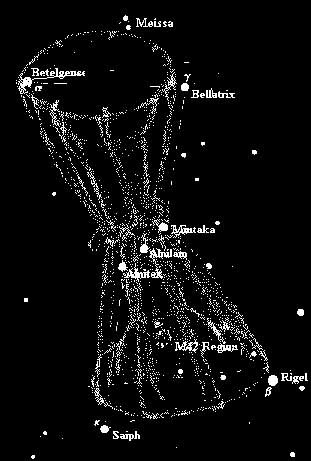
The trapezoidal form of the stars forming the drum's outer edges are sometimes called Waki Boshi and have given rise to another object with rhythmical associations. The striking together of two wooden blocks (Hyoushigi) is a part of many traditional Japanese religious ceremonies as well as entertainment. Probably of native rather than continental origin, the simple sound of the striking of these blocks against one another has added drama to Nou and Kabuki plays as well as signaled the beginning and end of religious ceremonies and even sporting events such as Sumo.

Such sound, in all its uses, is said to summon and gain the attention of protective deities. Japanese have found the "drama" of this simple instrument and its "sound" in Orion as Kanatsuki no Ryowaki Boshi (literally striking both sides stars; Uchida, 1973).
One figure seen in this configuration reflects a somewhat more delicate aesthetic than may be found in the more Western vision of a "mighty hunter". When these stars are near the zenith, some Japanese call the trapezoidal figure Sode Boshi (kimono sleeve stars, Nojiri, 1973; Uchida, 1973). Sleeves of a kimono are long, rectangular, and hang almost to the ground. Thus, the stars of Orion appear as though a woman has lifted her arm out, and (at least in latitudes similar to Japan) her decorative kimono sleeve drapes gracefully toward the Southern Sky.
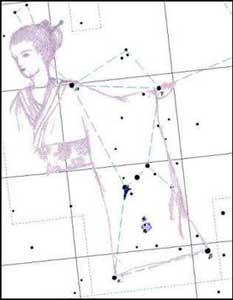
Depending upon the particular area of Japan and the predominant activity of people living there, job related objects were often seen in the three stars of the belt. For example, apparent equal spacing of Mitsu Boshi led people in areas whose primary industry related to construction or land management to see various types of linear measures such as Shakugo Boshi (ruler stars). In areas where bamboo was grown, people were likely to call the three belt stars Take no Fushi (bamboo joints) seeing each of the stars as a joint in a bamboo pole. In textile producing areas, ordinary citizens often visualized three prongs of a machine used in weaving thread and labeled the three stars Kase Boshi.
Mythology in Japan was primarily created to reinforce the direct lineal descendancy of the emperor, and the native religion of Shinto played an important role in this reinforcement. Shinto kami (gods, deities) were closely related to nature and could be found in most anything unusual, be it a rock outcropping or gnarled tree, but most certainly in ones ancestral lineage. Astrology was a definite import, used primarily in its Chinese form as a reinforcement or aid to imperial decision, and only in much later centuries of Japan's history did it find much use by common citizens. Even with the infusion of Buddhism into Japan, religion in the country really never took on the kind of moralistic tone of many Western religions or even the kind of "life beyond death" beliefs of Buddhism as it was found in many areas of the Asian continent.
Star lore related to fishing is somewhat more rare than that which is related to crop cultivation. It was primarily through cooperation of local farmers along with their local ancestral kami or gods in the production of rice that early Japanese rulers were able to fulfill their purpose of unifying the country under singular rule. Still, incorporating the legends of families of fishermen was an important part of this unification, and a mix of agrarian and fishing lore is sometimes found
Kami were seldom if ever seen to be persona who could wreak vengeance on "non-believers" or provide for a benevolent life hereafter. Rather, they served a kind of "here and now" protective and/or disruptive social function on both local and state levels as outlined earlier. They provided a foundation of "consciousness" through which the common person was expected to form his or her way of life.
A valued symbol reflective of native religious belief that is seen in Mitsu Boshi is expressed in the term Oyakoukou Boshi (Nojiri, 1973, 1988). This term, reflecting both linealism and vitalism, implies a kind of filial duty one has to ones parents. The three stars are viewed as the child holding up his/her parents or the three (parents and child) standing together. This familial symbol of "three" is found in many legends of Japan, and the belt stars of Orion are but one place in the heavens where this reminder of Japanese "consciousness" is seen.
The idea is further augmented in various Japanese star legends which concern persons dealing with oni (ogres) and finding their way to the heavens after some kind of chase. These legends include one in which brothers become the tale stars of Scorpio and another in which seven brothers become the seven stars of the "Big Dipper" or "North Seven Stars" (Uchida, 1973). The legend that includes the belt stars and M42 region of Orion involves two sisters.
According to Uchida, one day the sisters were walking down the road, the younger dutifully following her older sister and shouldering a tub of water. Being chased by an ogre, they found a rope leading to the heavens and began to climb.
Though the sisters escaped the ogre, the younger sister sadly had her foot bitten off. These days, we see the bamboo pole (Take no Fushi) with which she continues to carry water as she follows her sister (the moon) around the sky. Her remaining foot (M42 region) peeks from the folds of her kimono.
Western readers may find the end of this legend disturbing or even somewhat cruel.
However, all the fundamental values of Japanese "consciousness" are found in this story: filial duty, strength and courage, and a will to "go on" within ones present condition to an immediate brighter future. It is also interesting that this legend is one of the few related to the three belt stars which indeed makes allusion to its heritage as sei shuku or moon station. [As an aside to this legend, the area around M42 was seen to have three stars and was sometimes called Ko Mitsu Boshi or "Little Three Stars".
Obviously, much of the lore associated with Ko Mitsu Boshi was developed in relation to the three bright stars of the belt (Uchida, 1973; Nojiri, 1973, 1988). This association is sometimes called Muzura Boshi (six related stars). It was often said that the "three" stars of the M42 region "follow" the big Mitsu Boshi; hence they are called Mitsu Boshi no Tomo (Mitsu Boshi's Companions).
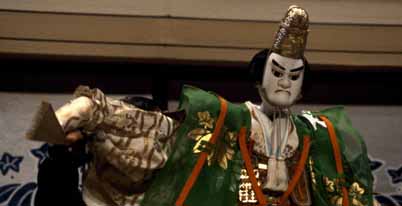
Much of the lore still passed on to children concerns specific events in the nation's history. In this regard, Orion's Betelgeuse and Rigel have special significance in many prefectures of Japan. Rigel is sometimes called Genji Boshi, and Betelgeuse is called Heike Boshi. These names refer to a particularly significant period in Japanese history and are related to the apparent colors of the two bright stars, white and red (though it may be argued that Rigel has a bit of a bluish tinge). The beginning of the Heian era (794-1192) found Japan with a new capital in Kyoto and continued exchange with China that had begun a few centuries before. However, in this era, political problems in China led to less exchange, and Japan began to enter one of its first major phases of isolation. While the emperor was the official ruler of Japan, then as so often in Japan's history, actual power began to fall more and more into the hands of powerful families.
The legendary war that brought the somewhat artistic and gentle Heian era to a close took place between the Taira (Heike) and Minamoto (Genji) families. The colors of Taira were red, and the colors of the Minamoto family were white. Ultimately the Minamoto (Rigel) family won the war and moved the capital to Kamakura, ushering in an era of Samurai warriors and leading to centuries of little true peace. This war gave rise to many famous stories and legends that later became part of Nou drama and Kabuki plays. These two bright stars of red and white still do battle with the steepes of the belt holding them apart.
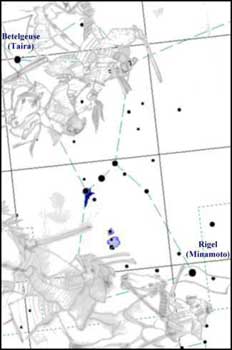
Due to the extraordinary bravery and loyalty exhibited by many members of both sides of this conflict, the colors of red and white came to have special significance that is still seen in present day Japan, most notable of course in the colors of the Japanese flag itself. Symbolizing duty, sacrifice, and loyalty, Rigel and Betelgeuse still are seen as reminders of these basic Japanese values. Thus, it may be quite appropriate that the bright stars of Betelgeuse and Rigel shine as emblems for the heritage of Heike and Genji.